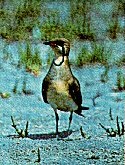 Synonyms: Common
names: Engl: Collared pratincole; Russ:
Lugovaya tirkushka; Turk: Bataklik kirlangici; Ukr:
Derykhvist luchny.
Synonyms: Common
names: Engl: Collared pratincole; Russ:
Lugovaya tirkushka; Turk: Bataklik kirlangici; Ukr:
Derykhvist luchny.Glareola pratincola (Linnaeus, 1758)
 Synonyms: Common
names: Engl: Collared pratincole; Russ:
Lugovaya tirkushka; Turk: Bataklik kirlangici; Ukr:
Derykhvist luchny.
Synonyms: Common
names: Engl: Collared pratincole; Russ:
Lugovaya tirkushka; Turk: Bataklik kirlangici; Ukr:
Derykhvist luchny.
Order (Scientific): CHARADRIIFORMES.
Family (Scientific): GLAREOLIDAE.
Taxonomic descriptions: The genus is widely distributed in Africa and S Asia. This is one of its two members known in the Black Sea region. Numbers are fluctuate widely over the years. Current estimate for the sea coast of Ukraine is 500-1,100 pairs.
 IUCN Status:
IUCN Status:
World level: EN
Black Sea Regional level: EN
Subregion level: EN
Distribution:
Habitats type, Critical habitats, Limiting factors: Breeds in low land salinas of sea bays and estuaries, brackish and fresh lakes, avoiding dense vegetation. Sometimes breeds successfully in degraded perennial herbs and fallow.
Biology: Breeding and in some places migratory species. In spring arrives in April, last birds come in late May. Breeding begins in mid May. Normal clutch consists of three eggs (2-5), nest is a deepening in the ground with light plant bedding. Colonies are usually loose and mixed with terns and waders, although mono-species settlements can be found too. Chicks leave the nests straight after hatching. Fledglings begin to concentrate by early July with adult birds always present. The major part of the population leaves for wintering grounds in August. Some birds stay till mid October. Glareola pratincola prey upon flying insects, sometimes may forage on the ground picking spiders. Feeding success depends on insect concentrations, in the areas where pesticides are applied may be very low.
Population trends: Slow, but constant decrease in breeding numbers.
Threats: Habitat transformation, cattle, and especially, sheep grazing, pesticides, high predation, human disturbance at the breeding sites.
Conservation measures taken: Expansion of the national parks in the coastal areas, setting up of water protection zones along all the water-bodies.
Conservation measures proposed:
References:
Compiled by: J.Chernichko.